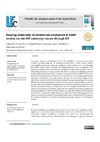Please use this identifier to cite or link to this item:
https://accedacris.ulpgc.es/jspui/handle/10553/70394
| DC Field | Value | Language |
|---|---|---|
| dc.contributor.author | Menéndez-Otero, Carlos | en_US |
| dc.contributor.author | Serrano-Gonzále, Raquel | en_US |
| dc.contributor.author | Gil-Naveira, Isabel | en_US |
| dc.date.accessioned | 2020-02-20T07:48:44Z | - |
| dc.date.available | 2020-02-20T07:48:44Z | - |
| dc.date.issued | 2018 | en_US |
| dc.identifier.issn | 1133-1127 | en_US |
| dc.identifier.uri | https://accedacris.ulpgc.es/handle/10553/70394 | - |
| dc.description.abstract | The paper presents an experience of use of ICT intended to overcome some of the problems currently plaguing ESP teaching at third level in Spain, namely student overcrowding, rising grade appealing, inadequacy and/or datedness of methodologies and syllabi, multi-campus lecturing, and disproportionate course management and assessment workload. The experience was developed in English for Commerce I, an on-site ESP required course in the curriculum of the BA in Commerce and Marketing currently taught at the University of Oviedo, during the first term of the year 2016/2017. The main aims were (1) to update the contents and methods of the course so that they allowed for significant, collaborative and autonomous learning of commercial English; (2) to significantly reduce the time the lecturers devoted to preparing, grading and reviewing tests, as well as handling student complaints, and (3) to greatly improve staff coordination so that uniformity of content and assessment could be guaranteed. The results show that aims (1) and (3) were fully met. As regards aim (2), even though ICT did reduce the time spent reviewing tests and handling complaints, the authors feel that the preparation of computer-assisted, on-site exams took longer than expected. Whereas the literature on the use of ICT in education mainly focuses on student motivation and engagement, the experience also bears out that ICT can be effectively used to combat student unhappiness by ensuring uniformity of content and assessment across sections in multi-section courses. | en_US |
| dc.description.abstract | El artículo presenta una experiencia de uso de TIC que tuvo como propósito superar algunos de los problemas que actualmente afectan a la enseñanza de IFE en la universidad española: masificación, aumento del número de reclamaciones de calificaciones, inadecuación y/u obsolescencia de metodologías y programas, docencia simultánea en varios campus, y crecimiento desproporcionado del tiempo que el profesorado debe dedicar a tareas administrativas y de evaluación. La experiencia se desarrolló en Inglés para Comercio I, una asignatura obligatoria y presencial del Grado en Comercio y Marketing que oferta la Universidad de Oviedo, durante el primer cuatrimestre del curso 2016/2017. Los objetivos principales fueron: (1) actualizar los contenidos y la metodología del curso para posibilitar el aprendizaje significativo, colaborativo y autónomo de inglés comercial; (2) reducir de forma significativa el tiempo que el profesorado dedicaba a preparar, calificar y revisar pruebas de evaluación, así como a tramitar quejas de los estudiantes, y (3) conseguir una importante mejora en la coordinación del profesorado, de manera que la unidad de docencia y evaluación quedase garantizada en todos los grupos de la asignatura. Los resultados muestran que la experiencia satisfizo plenamente los objetivos (1) y (3). En lo que respecta al objetivo (2), si bien las TIC redujeron el tiempo dedicado a revisar pruebas de evaluación y tramitar quejas, los autores consideran que la preparación de pruebas presenciales de evaluación con apoyo informático llevó más tiempo del esperado. Mientras que la literatura académica sobre el uso de las TIC en educación se centra prioritariamente en conseguir una mayor motivación y compromiso del estudiante, la experiencia también demuestra que estas tecnologías pueden resultar eficaces para combatir el descontento del alumnado, puesto que permiten garantizar la unidad de docencia y evaluación en asignaturas multigrupo. | en_US |
| dc.language | eng | en_US |
| dc.relation.ispartof | LFE. Revista de Lenguas para Fines Específicos | en_US |
| dc.source | LFE. Revista de lenguas para fines específicos [eISSN 2340-8561], v. 24 (2), p. 9-26 | en_US |
| dc.subject | 570107 Lengua y literatura | en_US |
| dc.subject | 550510 Filología | en_US |
| dc.subject.other | ICT | en_US |
| dc.subject.other | ESP | en_US |
| dc.subject.other | Uniformity of assessment | en_US |
| dc.subject.other | Commercial English | en_US |
| dc.subject.other | Multi-section courses | en_US |
| dc.subject.other | TIC | en_US |
| dc.subject.other | IFE | en_US |
| dc.subject.other | Unidad de evaluación | en_US |
| dc.subject.other | Inglés comercial | en_US |
| dc.subject.other | Asignaturas multigrupo | en_US |
| dc.title | Ensuring uniformity of content and assessment in multi-section, on-site ESP university courses through ICT | en_US |
| dc.title.alternative | Ensuring uniformity of content and assessment in on-site ESP university courses through ICT | en_US |
| dc.type | info:eu-repo/semantics/article | en_US |
| dc.type | Article | en_US |
| dc.identifier.doi | 10.20420/rlfe.2018.231 | en_US |
| dc.investigacion | Artes y Humanidades | en_US |
| dc.type2 | Artículo | en_US |
| dc.identifier.ulpgc | Sí | es |
| dc.description.esci | ESCI | |
| dc.description.dialnetimpact | 0,0 | |
| dc.description.dialnetq | Q1 | |
| dc.description.dialnetd | D2 | |
| dc.description.erihplus | ERIH PLUS | |
| item.grantfulltext | open | - |
| item.fulltext | Con texto completo | - |
| Appears in Collections: | Artículos | |
Page view(s)
61
checked on Jul 12, 2025
Download(s)
22
checked on Jul 12, 2025
Google ScholarTM
Check
Altmetric
Share
Export metadata
Items in accedaCRIS are protected by copyright, with all rights reserved, unless otherwise indicated.
